Solar eclipse of December 14, 1955
An annular solar eclipse occurred at the Moon's ascending node of orbit on Wednesday, December 14, 1955,[1] with a magnitude of 0.9176. A solar eclipse occurs when the Moon passes between Earth and the Sun, thereby totally or partly obscuring the image of the Sun for a viewer on Earth. An annular solar eclipse occurs when the Moon's apparent diameter is smaller than the Sun's, blocking most of the Sun's light and causing the Sun to look like an annulus (ring). An annular eclipse appears as a partial eclipse over a region of the Earth thousands of kilometres wide. Occurring only about 24 hours before apogee (on December 15, 1955, at 7:10 UTC), the Moon's apparent diameter was smaller.[2]
The duration of annularity at maximum eclipse (closest to but slightly shorter than the longest duration) was 12 minutes, 9.17 seconds in the Indian Ocean. It was the longest annular solar eclipse from December 17, 168 to January 14, 3080. Among all the 23740 solar eclipses from 4000 BC to 6000 AD, 7881 are annular, and only 3 of them are longer than this one.[3] This was the 20th member of Solar Saros 141, and the last of first set of solar eclipses without a penumbral internal contact (without a penumbra northern limit), the next event is the December 24, 1973 event, which is the first of 19 solar eclipses with a penumbral internal contact (has penumbral northern and southern limits) until 2298 Jul 09.
Annularity was visible from French Equatorial Africa (the part now belonging to Chad), Libya, Anglo-Egyptian Sudan (the part now belonging to Sudan) including the capital city Khartoum, French Somaliland (today's Djibouti) including the capital Djibouti City, British Somaliland (today's Somaliland) including the capital city Hargeisa, the Trust Territory of Somaliland (today's Somalia), the Maldives, Andaman and Nicobar Islands, Burma, Thailand including the capital city Bangkok, Cambodia, Laos, North Vietnam and South Vietnam (now belonging to Vietnam), China, British Hong Kong, Taiwan, and Ryukyu Islands. A partial eclipse was visible for parts of East Africa and Asia.
This was the third of four central solar eclipses visible from Bangkok from 1948 to 1958, where it is extremely rare for a large city to witness four central solar eclipses within 10 years.
Extreme duration
With a maximum length of annularity duration of 12 minutes and 9.17 seconds, this is the longest solar eclipse in the millennium, as well as the longest duration in Saros 141 and one of the longest eclipses ever observed. The annular path begins in northern Africa, then passing Maldives (near the maximum eclipse), then crosses just southern edge of Sri Lanka, then the track continues to some countries in Indochina and the track ends just slightly after the track passes Taiwan.
Observation
A joint team of the Georgetown University Astronomical Observatory, Washington, D.C. and the United States Air Force observed the annular eclipse in multiple locations around the world. Among them, in Khartoum, capital of Anglo-Egyptian Sudan, the partial phase started before sunrise, and the annular phase was shortly after sunrise. The team measured the refraction with the zenith distance between 80° and 90°.[4]
Eclipse details
Shown below are two tables displaying details about this particular solar eclipse. The first table outlines times at which the moon's penumbra or umbra attains the specific parameter, and the second table describes various other parameters pertaining to this eclipse.[5]
| Event | Time (UTC) |
|---|---|
| First Penumbral External Contact | 1955 December 14 at 04:01:44.4 UTC |
| First Umbral External Contact | 1955 December 14 at 05:10:54.4 UTC |
| First Central Line | 1955 December 14 at 05:14:41.0 UTC |
| First Umbral Internal Contact | 1955 December 14 at 05:18:29.1 UTC |
| Greatest Duration | 1955 December 14 at 07:01:01.9 UTC |
| Greatest Eclipse | 1955 December 14 at 07:02:25.1 UTC |
| Equatorial Conjunction | 1955 December 14 at 07:04:18.1 UTC |
| Ecliptic Conjunction | 1955 December 14 at 07:07:33.8 UTC |
| Last Umbral Internal Contact | 1955 December 14 at 08:46:19.4 UTC |
| Last Central Line | 1955 December 14 at 08:50:08.2 UTC |
| Last Umbral External Contact | 1955 December 14 at 08:53:55.4 UTC |
| Last Penumbral External Contact | 1955 December 14 at 10:03:06.4 UTC |
| Parameter | Value |
|---|---|
| Eclipse Magnitude | 0.91764 |
| Eclipse Obscuration | 0.84206 |
| Gamma | 0.42658 |
| Sun Right Ascension | 17h23m01.9s |
| Sun Declination | -23°10'20.1" |
| Sun Semi-Diameter | 16'14.9" |
| Sun Equatorial Horizontal Parallax | 08.9" |
| Moon Right Ascension | 17h22m58.2s |
| Moon Declination | -22°47'23.2" |
| Moon Semi-Diameter | 14'42.5" |
| Moon Equatorial Horizontal Parallax | 0°53'59.0" |
| ΔT | 31.3 s |
Eclipse season
This eclipse is part of an eclipse season, a period, roughly every six months, when eclipses occur. Only two (or occasionally three) eclipse seasons occur each year, and each season lasts about 35 days and repeats just short of six months (173 days) later; thus two full eclipse seasons always occur each year. Either two or three eclipses happen each eclipse season. In the sequence below, each eclipse is separated by a fortnight.
| November 29 Descending node (full moon) | December 14 Ascending node (new moon) |
|---|---|
 |  |
| Partial lunar eclipse Lunar Saros 115 | Annular solar eclipse Solar Saros 141 |
Related eclipses
Eclipses in 1955
- A penumbral lunar eclipse on January 8.
- A penumbral lunar eclipse on June 5.
- A total solar eclipse on June 20.
- A partial lunar eclipse on November 29.
- An annular solar eclipse on December 14.
Metonic
- Preceded by: Solar eclipse of February 25, 1952
- Followed by: Solar eclipse of October 2, 1959
Tzolkinex
- Preceded by: Solar eclipse of November 1, 1948
- Followed by: Solar eclipse of January 25, 1963
Half-Saros
- Preceded by: Lunar eclipse of December 8, 1946
- Followed by: Lunar eclipse of December 19, 1964
Tritos
- Preceded by: Solar eclipse of January 14, 1945
- Followed by: Solar eclipse of November 12, 1966
Solar Saros 141
- Preceded by: Solar eclipse of December 2, 1937
- Followed by: Solar eclipse of December 24, 1973
Inex
- Preceded by: Solar eclipse of January 3, 1927
- Followed by: Solar eclipse of November 22, 1984
Triad
- Preceded by: Solar eclipse of February 11, 1869
- Followed by: Solar eclipse of October 14, 2042
Solar eclipses of 1953–1956
This eclipse is a member of a semester series. An eclipse in a semester series of solar eclipses repeats approximately every 177 days and 4 hours (a semester) at alternating nodes of the Moon's orbit.[6]
The partial solar eclipses on February 14, 1953 and August 9, 1953 occur in the previous lunar year eclipse set.
| Solar eclipse series sets from 1953 to 1956 | ||||||
|---|---|---|---|---|---|---|
| Descending node | Ascending node | |||||
| Saros | Map | Gamma | Saros | Map | Gamma | |
| 116 | July 11, 1953 Partial | 1.4388 | 121 | January 5, 1954 Annular | −0.9296 | |
| 126 | June 30, 1954 Total | 0.6135 | 131 | December 25, 1954 Annular | −0.2576 | |
| 136 | June 20, 1955 Total | −0.1528 | 141 | December 14, 1955 Annular | 0.4266 | |
| 146 | June 8, 1956 Total | −0.8934 | 151 | December 2, 1956 Partial | 1.0923 | |
Saros 141
This eclipse is a part of Saros series 141, repeating every 18 years, 11 days, and containing 70 events. The series started with a partial solar eclipse on May 19, 1613. It contains annular eclipses from August 4, 1739 through October 14, 2640. There are no hybrid or total eclipses in this set. The series ends at member 70 as a partial eclipse on June 13, 2857. Its eclipses are tabulated in three columns; every third eclipse in the same column is one exeligmos apart, so they all cast shadows over approximately the same parts of the Earth.
The longest duration of annularity was produced by member 20 at 12 minutes, 9 seconds on December 14, 1955. All eclipses in this series occur at the Moon’s ascending node of orbit.[7]
| Series members 12–33 occur between 1801 and 2200: | ||
|---|---|---|
| 12 | 13 | 14 |
 September 17, 1811 |  September 28, 1829 |  October 9, 1847 |
| 15 | 16 | 17 |
 October 19, 1865 |  October 30, 1883 |  November 11, 1901 |
| 18 | 19 | 20 |
 November 22, 1919 |  December 2, 1937 |  December 14, 1955 |
| 21 | 22 | 23 |
 December 24, 1973 |  January 4, 1992 |  January 15, 2010 |
| 24 | 25 | 26 |
 January 26, 2028 |  February 5, 2046 |  February 17, 2064 |
| 27 | 28 | 29 |
 February 27, 2082 |  March 10, 2100 |  March 22, 2118 |
| 30 | 31 | 32 |
 April 1, 2136 |  April 12, 2154 |  April 23, 2172 |
| 33 | ||
 May 4, 2190 | ||
Metonic series
The metonic series repeats eclipses every 19 years (6939.69 days), lasting about 5 cycles. Eclipses occur in nearly the same calendar date. In addition, the octon subseries repeats 1/5 of that or every 3.8 years (1387.94 days). All eclipses in this table occur at the Moon's ascending node.
| 22 eclipse events between December 13, 1898 and July 20, 1982 | ||||
|---|---|---|---|---|
| December 13–14 | October 1–2 | July 20–21 | May 9 | February 24–25 |
| 111 | 113 | 115 | 117 | 119 |
 December 13, 1898 |  July 21, 1906 |  May 9, 1910 |  February 25, 1914 | |
| 121 | 123 | 125 | 127 | 129 |
 December 14, 1917 |  October 1, 1921 |  July 20, 1925 |  May 9, 1929 |  February 24, 1933 |
| 131 | 133 | 135 | 137 | 139 |
 December 13, 1936 |  October 1, 1940 |  July 20, 1944 |  May 9, 1948 |  February 25, 1952 |
| 141 | 143 | 145 | 147 | 149 |
 December 14, 1955 |  October 2, 1959 |  July 20, 1963 |  May 9, 1967 |  February 25, 1971 |
| 151 | 153 | 155 | ||
 December 13, 1974 |  October 2, 1978 |  July 20, 1982 | ||
Tritos series
This eclipse is a part of a tritos cycle, repeating at alternating nodes every 135 synodic months (≈ 3986.63 days, or 11 years minus 1 month). Their appearance and longitude are irregular due to a lack of synchronization with the anomalistic month (period of perigee), but groupings of 3 tritos cycles (≈ 33 years minus 3 months) come close (≈ 434.044 anomalistic months), so eclipses are similar in these groupings.
| Series members between 1801 and 2200 | ||||
|---|---|---|---|---|
 February 21, 1803 (Saros 127) | 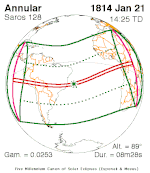 January 21, 1814 (Saros 128) |  December 20, 1824 (Saros 129) |  November 20, 1835 (Saros 130) |  October 20, 1846 (Saros 131) |
 September 18, 1857 (Saros 132) | 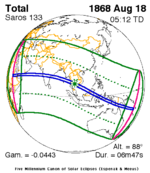 August 18, 1868 (Saros 133) |  July 19, 1879 (Saros 134) |  June 17, 1890 (Saros 135) |  May 18, 1901 (Saros 136) |
 April 17, 1912 (Saros 137) |  March 17, 1923 (Saros 138) |  February 14, 1934 (Saros 139) |  January 14, 1945 (Saros 140) |  December 14, 1955 (Saros 141) |
 November 12, 1966 (Saros 142) |  October 12, 1977 (Saros 143) |  September 11, 1988 (Saros 144) |  August 11, 1999 (Saros 145) |  July 11, 2010 (Saros 146) |
 June 10, 2021 (Saros 147) |  May 9, 2032 (Saros 148) |  April 9, 2043 (Saros 149) |  March 9, 2054 (Saros 150) |  February 5, 2065 (Saros 151) |
 January 6, 2076 (Saros 152) |  December 6, 2086 (Saros 153) |  November 4, 2097 (Saros 154) |  October 5, 2108 (Saros 155) |  September 5, 2119 (Saros 156) |
 August 4, 2130 (Saros 157) |  July 3, 2141 (Saros 158) |  June 3, 2152 (Saros 159) |  April 1, 2174 (Saros 161) | |
Inex series
This eclipse is a part of the long period inex cycle, repeating at alternating nodes, every 358 synodic months (≈ 10,571.95 days, or 29 years minus 20 days). Their appearance and longitude are irregular due to a lack of synchronization with the anomalistic month (period of perigee). However, groupings of 3 inex cycles (≈ 87 years minus 2 months) comes close (≈ 1,151.02 anomalistic months), so eclipses are similar in these groupings.
| Series members between 1801 and 2200 | ||
|---|---|---|
 March 24, 1811 (Saros 136) |  March 4, 1840 (Saros 137) |  February 11, 1869 (Saros 138) |
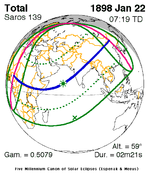 January 22, 1898 (Saros 139) |  January 3, 1927 (Saros 140) |  December 14, 1955 (Saros 141) |
 November 22, 1984 (Saros 142) |  November 3, 2013 (Saros 143) |  October 14, 2042 (Saros 144) |
 September 23, 2071 (Saros 145) |  September 4, 2100 (Saros 146) | 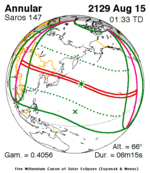 August 15, 2129 (Saros 147) |
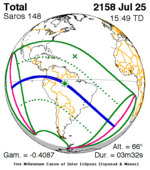 July 25, 2158 (Saros 148) |  July 6, 2187 (Saros 149) | |
Notes
- ^ "December 14, 1955 Annular Solar Eclipse". timeanddate. Retrieved 5 August 2024.
- ^ "Moon Distances for London, United Kingdom, England". timeanddate. Retrieved 5 August 2024.
- ^ "Annular Solar Eclipses with Durations Exceeding 11m 00s: -3999 to 6000". NASA Eclipse Web Site.
- ^ DE KORT, JULES (30 September 1960). "MEASUREMENTS OF THE SUN'S LIMB FOR THE DETERMINATION OF REFRACTION BETWEEN 80 DEGREES AND 90 DEGREES ZENITH DISTANCE". GEORGETOWN COLL WASHINGTON D C OBSERVATORY. Archived from the original on 28 April 2016.
- ^ "Annular Solar Eclipse of 1955 Dec 14". EclipseWise.com. Retrieved 5 August 2024.
- ^ van Gent, R.H. "Solar- and Lunar-Eclipse Predictions from Antiquity to the Present". A Catalogue of Eclipse Cycles. Utrecht University. Retrieved 6 October 2018.
- ^ "NASA - Catalog of Solar Eclipses of Saros 141". eclipse.gsfc.nasa.gov.
References
- Earth visibility chart and eclipse statistics Eclipse Predictions by Fred Espenak, NASA/GSFC
- Google interactive map
- Besselian elements
- v
- t
- e
| By era | |
|---|---|
| Saros series (list) | |
| Visibility | |
| Historical |
|

Total/hybrid eclipses
→ next total/hybrid
- 1133
- 1185
- 1560
- 1598
- 1652
- 1654
- 1673
- 1706
- 1715
- 1724
- 1766
- 1778
- 1780
- 1806
- 1816
- 1824
- 1842
- 1851
- 1853
- 1857
- 1858
- 1860
- 1865
- 1867
- 1868
- 1869
- 1870
- 1871
- 1874
- 1875
- 1878
- 1882
- 1883
- 1885
- 1886
- 1887
- Jan. 1889
- Dec. 1889
- 1893
- 1896
- 1898
- 1900
- 1901
- 1903
- 1904
- 1905
- 1907
- Jan. 1908
- Dec. 1908
- 1909
- 1910
- 1911
- Apr. 1912
- Oct. 1912
- 1914
- 1916
- 1918
- 1919
- 1921
- 1922
- 1923
- 1925
- 1926
- 1927
- 1928
- 1929
- Apr. 1930
- Oct. 1930
- 1932
- 1934
- 1936
- 1937
- 1938
- 1939
- 1940
- 1941
- 1943
- Jan. 1944
- 1945
- 1947
- 1948
- 1950
- 1952
- 1954
- 1955
- 1956
- 1957
- 1958
- 1959
- 1961
- 1962
- 1963
- 1965
- 1966
- 1967
- 1968
- 1970
- 1972
- 1973
- 1974
- 1976
- 1977
- 1979
- 1980
- 1981
- 1983
- 1984
- 1985
- 1986
- 1987
- 1988
- 1990
- 1991
- 1992
- 1994
- 1995
- 1997
- 1998
- 1999
- 2001
- 2002
- 2003
- 2005
- 2006
- 2008
- 2009
- 2010
- 2012
- 2013
- 2015
- 2016
- 2017
- 2019
- 2020
- 2021
- 2023
- 2024
- → 2026
- 2027
- 2028
- 2030
- 2031
- 2033
- 2034
- 2035
- 2037
- 2038
- 2039
- 2041
- 2042
- 2043
- 2044
- 2045
- 2046
- 2048
- 2049
- 2050
- 2052
- 2053
- 2055
- Jan. 2057
- Dec. 2057
- 2059
- 2060
- 2061
- 2063
- 2064
- 2066
- 2067
- 2068
- 2070
- 2071
- 2072
- 2073
- 2075
- 2076
- 2077
- 2078
- 2079
- 2081
- 2082
- 2084
- 2086
- 2088
- 2089
- 2090
- 2091
- 2093
- 2094
- 2095
- 2096
- 2097
- 2099
- 2100
- 2186

Annular eclipses
→ next annular
- 1820
- 1854
- 1879
- 1889
- 1900
- 1901
- 1903
- 1904
- 1905
- 1907
- 1908
- 1911
- 1914
- Feb. 1915
- Aug. 1915
- 1916
- 1917
- 1918
- 1919
- 1921
- 1922
- 1923
- 1925
- 1926
- 1927
- 1929
- 1932
- Feb. 1933
- Aug. 1933
- 1934
- 1935
- 1936
- 1937
- 1939
- 1940
- 1941
- 1943
- Jul. 1944
- 1945
- 1947
- 1948
- 1950
- Mar. 1951
- Sep. 1951
- 1952
- Jan. 1954
- Dec. 1954
- 1955
- 1957
- 1958
- 1959
- 1961
- 1962
- 1963
- 1965
- 1966
- Mar. 1969
- Sep. 1969
- 1970
- 1972
- Jan. 1973
- Dec. 1973
- 1976
- 1977
- 1979
- 1980
- 1981
- 1983
- 1984
- 1987
- 1988
- 1990
- 1991
- 1992
- 1994
- 1995
- 1998
- 1999
- 2001
- 2002
- 2003
- 2005
- 2006
- 2008
- 2009
- 2010
- 2012
- 2013
- 2014
- 2016
- 2017
- 2019
- 2020
- 2021
- 2023
- → 2024
- 2026
- 2027
- 2028
- 2030
- 2031
- 2032
- 2034
- 2035
- 2036
- Jan. 2038
- Jul. 2038
- 2039
- 2041
- 2042
- 2043
- 2044
- 2045
- 2046
- 2048
- 2049
- 2052
- 2053
- Jan. 2056
- Jul. 2056
- 2057
- 2059
- 2060
- 2061
- 2063
- 2064
- 2066
- 2067
- 2070
- 2071
- Jan. 2074
- Jul. 2074
- 2075
- 2077
- 2078
- 2079
- 2081
- 2082
- 2084
- Jun. 2085
- Dec. 2085
- 2088
- 2089
- Feb. 2092
- Aug. 2092
- 2093
- 2095
- 2096
- 2097
- 2099
- 2100

Partial eclipses
→ next partial
- Jan. 1639
- Apr. 1902
- May 1902
- Oct. 1902
- Feb. 1906
- Jul. 1906
- Aug. 1906
- Dec. 1909
- Nov. 1910
- Apr. 1913
- Aug. 1913
- Sep. 1913
- Dec. 1916
- Jan. 1917
- Jun. 1917
- Jul. 1917
- May 1920
- Nov. 1920
- Mar. 1924
- Jul. 1924
- Aug. 1924
- Dec. 1927
- Jun. 1928
- Nov. 1928
- Apr. 1931
- Sep. 1931
- Oct. 1931
- Jan. 1935
- Feb. 1935
- Jun. 1935
- Jul. 1935
- Nov. 1938
- Mar. 1942
- Aug. 1942
- Sep. 1942
- Jan. 1946
- May 1946
- Jun. 1946
- Nov. 1946
- Apr. 1949
- Oct. 1949
- Feb. 1953
- Jul. 1953
- Aug. 1953
- Dec. 1956
- Mar. 1960
- Sep. 1960
- Jan. 1964
- Jun. 1964
- Jul. 1964
- Dec. 1964
- May 1967
- Mar. 1968
- Feb. 1971
- Jul. 1971
- Aug. 1971
- Dec. 1974
- May 1975
- Nov. 1975
- Apr. 1978
- Oct. 1978
- Jan. 1982
- Jun. 1982
- Jul. 1982
- Dec. 1982
- May 1985
- Apr. 1986
- Mar. 1989
- Aug. 1989
- Dec. 1992
- May 1993
- Nov. 1993
- Apr. 1996
- Oct. 1996
- Sep. 1997
- Feb. 2000
- 1 Jul. 2000
- 31 Jul. 2000
- Dec. 2000
- Apr. 2004
- Oct. 2004
- Mar. 2007
- Sep. 2007
- Jan. 2011
- Jun. 2011
- Jul. 2011
- Nov. 2011
- Oct. 2014
- Sep. 2015
- Feb. 2018
- Jul. 2018
- Aug. 2018
- Jan. 2019
- Apr. 2022
- Oct. 2022
- → Mar. 2025
- Sep. 2025
- Jan. 2029
- Jun. 2029
- Jul. 2029
- Dec. 2029
- 2032
- 2033
- Feb. 2036
- Jul. 2036
- Aug. 2036
- 2037
- May 2040
- Nov. 2040
- Jan. 2047
- Jun. 2047
- Jul. 2047
- Dec. 2047
- 2050
- Apr. 2051
- Oct. 2051
- Mar. 2054
- Aug. 2054
- Sep. 2054
- 2055
- May 2058
- Jun. 2058
- Nov. 2058
- Mar. 2062
- Sep. 2062
- Feb. 2065
- Jul. 2065
- Aug. 2065
- Dec. 2065
- 2068
- Apr. 2069
- May 2069
- Oct. 2069
- 2072
- 2073
- Jun. 2076
- Jul. 2076
- Nov. 2076
- Feb. 2083
- Jul. 2083
- Aug. 2083
- 2084
- 2086
- May 2087
- Jun. 2087
- Oct. 2087
- 2090
- 2091
- Jun. 2094
- Jul. 2094
- Dec. 2094
- Apr. 2098
- Sep. 2098
- Oct. 2098
 Astronomy portal
Astronomy portal Solar System portal
Solar System portal Category
Category














